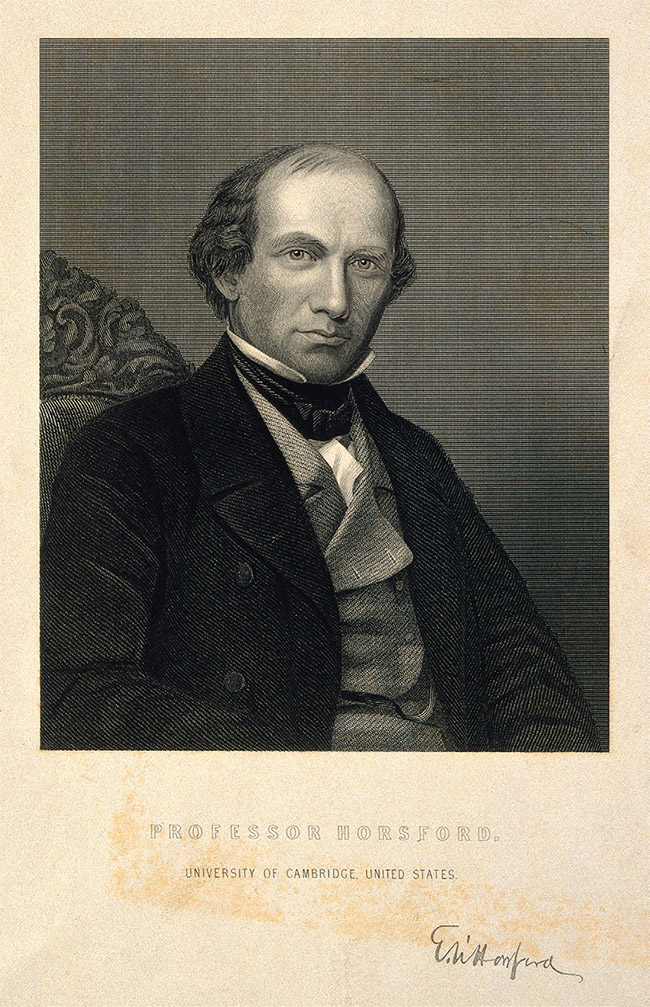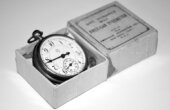A Colorful History of Baking Powder (And Its Unlikely Inventor)

If you look in your kitchen cabinet right now, chances are pretty good that you’ll be able to find a can of baking powder. It’s so commonplace today that it’s hard to imagine someone invented it, but modern baking powder was created in the 1850s by a colorful Harvard chemist named Eben Norton Horsford.

Today, baking powder is a mixture of three ingredients: baking soda, also known as sodium bicarbonate; a weak acid, such as monocalcium phosphate; and a filler such as corn starch. Each of the three ingredients plays an important role in the leavening process that allows cakes and quick breads to attain their characteristic light, fluffy texture. Baking soda, chemically speaking, is a base. Monocalcium phosphate is baking soda’s opposite, an acid. When these acids and bases are combined in water, they interact chemically, resulting in the release of carbon dioxide, a gas. The carbon dioxide creates the pockets of air in a baked good, keeping it from becoming a dense brick of flour and sugar. The third ingredient, corn starch, is a desiccant; it absorbs moisture from the atmosphere, keeping the two main ingredients dry so they do not interact prematurely. This allows the resulting chemical reaction to be predictable, which means that bakers using the same amount of baking powder will achieve the same amount of rising action in every cake.
In the 1800s, yeasts were thought by some people to be agents of decay and even associated with moral failing.
For millennia, bakers used yeast to generate leavening in their breads. Yeasts are microscopic fungi; even in the dried form used by bakers today they are living organisms. Yeast cells feed on starches and sugars such as those in wheat flour. As yeast cells digest their food, they release carbon dioxide, which makes bread dough rise. As a natural product, yeast can be unpredictable; a given weight of dried yeast may contain a mixture of inactive and living organisms or yeasts of different strains and potency. In the 1800s, yeasts were thought by some people to be agents of decay and even associated with moral failing. Scientists began the search for more reliable leavening agents. In the 1840s, cream of tartar — a byproduct of wine making — was found to generate carbon dioxide when mixed with baking soda. But in the 19th century, wine production was mostly limited to Europe, meaning that American bakers had to import cream of tartar at great expense.

Horsford began to study the problem in 1854. He proposed a substitute for cream of tartar: monocalcium phosphate made by treating animal bones with sulfuric acid. Horsford received a patent in 1856 for the process of making monocalcium phosphate. To prevent a premature reaction between the two primary chemical agents in his baking powder, Horsford proposed adding corn starch so that the ingredients could be packaged together, mixed in the correct proportions in a factory, and shipped ready for use by bakers. Horsford — who held the title of Rumford Professor and Lecturer on the Application of Science to the Useful Arts at Harvard — established the Rumford Chemical Works in East Providence, Rhode Island, where he manufactured the new product. The American Chemical Society considers the invention of baking powder of such importance that in 2006 it named the development of baking powder a National Historic Chemical Landmark.
In 1861, Horsford published “The Theory and Art of Bread Making: A New Process without the Use of Ferment.” In the tract, he promoted the use of his chemical leavening over yeast. Horsford argued that the nutritional value of white bread was reduced by the action of yeast and the removal of phosphate-rich wheat bran. He noted that the chemical leavening he had invented worked more quickly than yeast (which often requires hours of rising time) and that baking powder required less skill from the home baker than recipes using yeast. He believed that the only purpose of yeast in bread making is to develop the air bubbles that permit easy human digestion of wheat.
Today, with the abundance of industrially produced foods available in America, Horsford’s concern for the humble loaf of bread may seem quaint. However, in the 19th century, hunger was widespread, and inadequate nutrition even more common. As with so many areas of scientific investigation, food science promised to improve the health, robustness, and productivity of humankind.
Horsford is credited as the inventor of condensed milk, which he reportedly created for use on the Arctic expeditions of explorer Elisha Kane.
Horsford was a somewhat unlikely hero in this arena. A New York native, he studied civil engineering, not agriculture or chemistry, at the Rensselaer School (now Rensselaer Polytechnic Institute) in Troy, New York. His interest in nutrition came during two years of advanced study at the University of Giessen in Germany. Horsford accepted the Rumford Professorship at Harvard in 1847 and taught chemistry there for 16 years.
Horsford had wide-ranging interests as a chemist and was a prolific author of scientific papers and reports. He analyzed grains and vegetables for their nutritional content. During the Civil War, he consulted with the U.S. Army on efficient ways to feed soldiers in battle and developed a ration of compressed beef and parched wheat grits; half a million packages were prepared per Ulysses S. Grant’s orders. Horsford advised the city of Boston on the best metal to use in its water distribution pipes. For the Massachusetts State Board of Health, he investigated the source of offensive odors near a meat packing plant in East Cambridge. He is credited as the inventor of condensed milk, which he reportedly created for use on the Arctic expeditions of explorer Elisha Kane. One of Horsford’s assistants sold the process for condensing milk to the Borden Company, which continues to make it. All told, Horsford received 30 patents for his discoveries. Leaving Harvard in 1863 due to the demands placed on him by his business interests, he spent the remainder of his career commercializing his discoveries and became a wealthy man.

In later life, Horsford became convinced that a group of Norsemen led by Leif Erikson had established a walled city in Watertown, Massachusetts, in the 11th century. In 1887, he delivered an address at Faneuil Hall in Boston trumpeting the “Discovery of America by Northmen” and dedicating a statue of Erikson. His argument rested on his interpretation of early maps of the North American coast and his assertion that several place names in Massachusetts were of Norse origin. In 1889, he published “The Discovery of the Ancient City of Norumbega,” followed two years later by “The Defences of Norumbega,” based on archaeological investigations in Watertown.
In the 1889 work, Horsford grandly announced: “I have today the honor of announcing to you the discovery of Vinland, including the Landfall of Leif Erikson and the Site of his Houses. I have also to announce to you the discovery of the site of the ancient City of Norumbega.” A review of the 1891 book in Science magazine noted: “He believes that he has discovered its stone-built walls, its ancient stone-paved streets, and the remains of its docks and wharves. Other local antiquaries see in these remains merely the vestiges of some dams, drains, and stone fences of the early New England farmers, and it appears that Professor Horsford has not succeeded in persuading any of the resident investigators of the interpretation he has so much at heart.” Nonetheless, in 1892 Horsford was knighted by the king of Denmark for his archaeological research on the Norse people.

Subsequent research has not supported Horsford’s claims of Viking settlements in New England. But evidence of his conviction endures. On a lonely spot at the intersection of Memorial Drive and Gerry’s Landing Road in Cambridge, behind Mount Auburn Hospital, a stone monument reads “On This Spot in the Year 1000 Leif Erikson Built His House in Vinland.” Erection of the marker was funded by Horsford and his baking powder profits. Putting his wealth to perhaps more fruitful use, he became a major benefactor of Wellesley College, endowing its library, establishing a fund for scientific instruments, and creating a pension fund.
An obituary in the Proceedings of the American Academy of Arts and Sciences notes that “After his retirement from his professorship, he continued to live in Cambridge until his death, as it had become endeared to him by his long residence and the brilliant society in which it then rejoiced.” The stately home he built on Craigie Street in Cambridge in 1854 remains a private residence.
Karen Weintraub is a journalist, now working as health reporter at USA Today. Her work has appeared in the New York Times, the Washington Post, Scientific American, and STAT, and she is the coauthor of “The Autism Revolution” and “Fast Minds.“
Michael Kuchta is an architect and campus planner.
Weintraub and Kuchta are the authors of “Born in Cambridge,” from which this article is excerpted.



